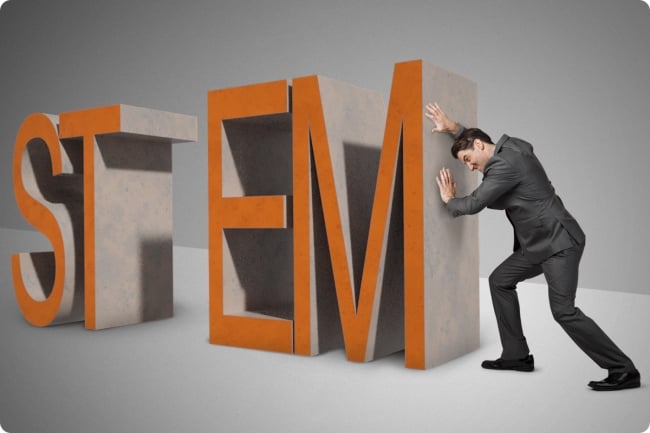You have /5 articles left.
Sign up for a free account or log in.

A recent study adds to data debunking the myth that equity in STEM education requires lowering academic standards.
Photo illustration by Justin Morrison/Inside Higher Ed | Getty Images
Many have argued that increasing diversity and inclusion in STEM comes at the cost of lowering standards, but a recent report adds to what its authors say is “a growing literature” that debunks these claims. Instead, the report’s findings show that slight changes to course structure could close or even remove equity gaps without altering the level of mastery expected.
“There’s a predominant myth that you need to lower the intellectual level of a course in order to accommodate diversity and inclusion,” said Cassandra Paul, a physics education researcher at San José State University and co-author of the report. “That’s something that we want to push back on.” The report, published earlier this month in Physical Review Physics Education Research, observed how two separate structural changes made to introductory physics courses each closed a historic grade gap for a different minority group.
One variation altered the order in which course content was introduced. The other altered how tests were given. Both resulted in narrower achievement gaps. The analysis concludes that professors should stop approaching instruction from a “student deficit” perspective and start thinking about a “course deficit.”
“In higher education in general, I think people ought to allow the possibility that it’s not problems with their students that lead to the results,” said David Webb, the other co-author of the report and a senior lecturer emeritus at the University of California, Davis. “It may be problems with their course.”
Altering Order and Assessment
The report was based on two studies, both conducted in introductory-level physics courses at UC Davis, all with class sizes of 160 to 180 students.
The first experiment changed the order in which the course curriculum was taught. Instead of the instructor introducing core foundational concepts while simultaneously having students apply them to complex calculations, the instructor used a “concepts first” model. Under that model, the instructor spent the first 60 percent of the semester familiarizing students with main ideas, testing their knowledge by asking them to use words, graphs, diagrams and simple equations to identify and describe the relationships between physical variables. The class later applied those concepts to more complex, multi-equation calculations.
The second study, conducted about six years ago, altered how students were tested and switched weekly tests to biweekly. This gave students time to retake the previous test and allowed for the higher score to be used toward their final grade. (No changes were made to the final exam.)
Both course adjustments helped close the grade gap for at least one minority group, but neither change had an impact on all students. While the “concept first” model eliminated the grade gap between racial minorities and white students, the gap between men and women remained. The change to testing eliminated a deficit for women but not for racial minorities, on the other hand.
Both Paul and Webb chuckled when asked why the gap closed for one group but not the other.
“David and I are smiling, because everybody wants a mechanism? I totally get why, and I think we have some speculation on that,” Paul said. “But I think this is a good time to say that we think the emphasis really should be on the fact that this is possible.”
They agreed that factors such as increased opportunities for student engagement with the course content, building higher levels of trust between instructor and student, and variations in study habits may have influenced the outcomes.
“People from different backgrounds have different behaviors that may not be aligned with the traditions that exist in higher education,” Paul said. “Therefore, it’s not really that surprising to me that one structural thing has an impact on one demographic group and not the other.”
Growing Evidence
Andrew Heckler, a physics professor at Ohio State University who specializes in physics education research, said Webb and Paul’s research was important, but he remains cautious about overgeneralization.
“This is just one study … You want to be very careful about generalizing that to all populations and all situations,” he said. “This paper is further motivation for people to try this and see if it works in their situation as well … I’m excited about it.”
Other research has already produced similar findings.
Heckler, along with a graduate student, Amber Simmons, conducted a study published in 2020 that analyzed how shifting the weight of certain assessments in the overall term grade in physics courses could also close equity gaps. The findings show that while white male students often perform better than female, Black and Hispanic peers on exams, the gap is significantly smaller on other course components such as labs or homework.
“The idea is that assessing things in different ways is bringing out different knowledge and skills in different students,” he said. “How you reward and what you assess basically determines who does well. If you weigh the exams less than these other components, then the gap between white males and everybody else decreases.”
Other studies have found significantly smaller grade gaps for underrepresented student groups in courses taught via active learning compared to a traditional lecture.
“We’re coming to a point in education where the evidence is starting to become so overwhelming that it’s almost our ethical responsibility to change what we do,” Heckler said. “We can’t ignore these kinds of results; we have to look at them and try to see if they can be replicated in our own institution. The responsibility is on us.”
‘We Can Act’
Kelly Hogan, a biology professor at Duke University who focuses on inclusive teaching, said Webb and Paul’s findings are reflected in an analogy about fish and groundwater.
“If one fish in a lake is found dead, you might ask, what was wrong with the fish. But if lots of fish are found dead, you have to start asking about the water in the lake. And if fish are found dead in many lakes around a region, you have to start asking what is wrong with the nonvisible groundwater that connects the lakes,” Hogan explained.
She said that while many of the conversations about systemic inequities can feel overwhelming for individual educators, this paper provides a starting point.
“These changes are about each context and experimenting in one’s own discipline and environment,” Hogan said. “The study provides a road map for the ways one might change course structure and see a leveling for certain demographics. But it’s a journey.”
Scott Freeman, a teaching professor emeritus in the biology department at the University of Washington, viewed Webb and Paul’s report as a “broadly applicable” path to equity, “at least in STEM.” He hopes their research, and more like it, will help educators rethink a system that was designed with a “sink-or-swim” mentality “created to educate the elite.”
“It’s particularly powerful now because campuses are just awash with talk about diversity, equity, inclusion, and everyone’s tripping over each other to say how important this is to them and their institution,” he said. “But there’s a lot of talk and not much action. The authors of this paper, along with work that I and many others have been involved with, show we can act in our classrooms.”




